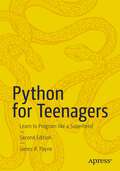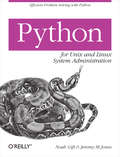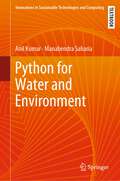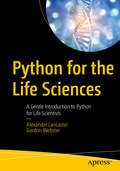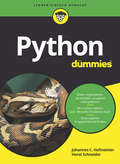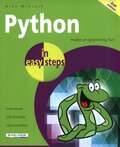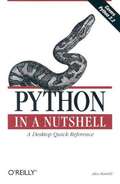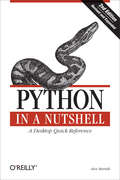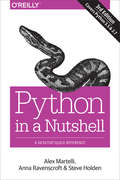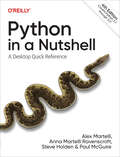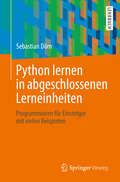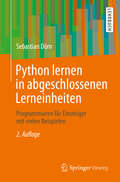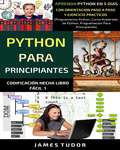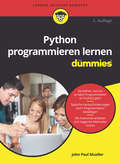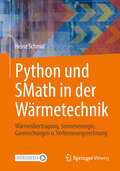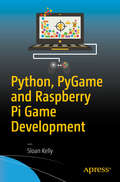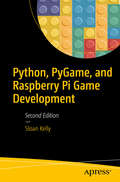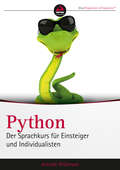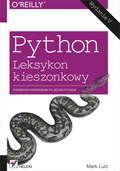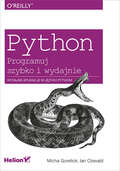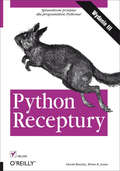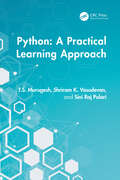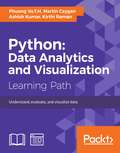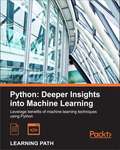- Table View
- List View
Python for Teenagers: Learn to Program like a Superhero!
by James R. PayneThis book, which is designed for middle-school through college-aged students, will arm beginners with solid programming foundations they can carry throughout life. It uses fun and simple language (and programming examples) to teach the fundamentals needed to start the down path of becoming a programmer. Python is a highly flexible language, allowing developers to enter any number of technical fields and is a welcome addition to any resume. With its low learning curve, it makes a great introductory language, as new developers can take the coding fundamentals they learn in Python and apply them to any other language. The second edition builds upon the foundation of the first book, revising all the chapters where the language has changed, updating the commands, code, and examples to bring it up to date with the current version of Python. Since Python is the most popular programming language in the world and can be used in conjunction with other languages - across multiple platforms - it can increase the reader's ability to qualify for a wider range of jobs than other languages. Finally, Python is fun - something not every programming language can boast! What You Will Learn Install and configure PythonGrasp basic software development principles and syntaxUnderstand the best practices for coding in PythonCreate applications and debug code Who This Book Is For The book’s target audience is primarily middle school to college aged students looking to learn how to program computers and develop software. Older individuals and computer programmers who know other languages and want to add Python to their repertoire can also benefit from the book.
Python for Unix and Linux System Administration
by Jeremy Jones Noah GiftPython is an ideal language for solving problems, especially in Linux and Unix networks. With this pragmatic book, administrators can review various tasks that often occur in the management of these systems, and learn how Python can provide a more efficient and less painful way to handle them. Each chapter in Python for Unix and Linux System Administration presents a particular administrative issue, such as concurrency or data backup, and presents Python solutions through hands-on examples. Once you finish this book, you'll be able to develop your own set of command-line utilities with Python to tackle a wide range of problems. Discover how this language can help you: Read text files and extract information Run tasks concurrently using the threading and forking options Get information from one process to another using network facilities Create clickable GUIs to handle large and complex utilities Monitor large clusters of machines by interacting with SNMP programmatically Master the IPython Interactive Python shell to replace or augment Bash, Korn, or Z-Shell Integrate Cloud Computing into your infrastructure, and learn to write a Google App Engine Application Solve unique data backup challenges with customized scripts Interact with MySQL, SQLite, Oracle, Postgres, Django ORM, and SQLAlchemy With this book, you'll learn how to package and deploy your Python applications and libraries, and write code that runs equally well on multiple Unix platforms. You'll also learn about several Python-related technologies that will make your life much easier.
Python for Unix and Linux System Administration
by Noah Gift Jeremy M. JonesPython is an ideal language for solving problems, especially in Linux and Unix networks. With this pragmatic book, administrators can review various tasks that often occur in the management of these systems, and learn how Python can provide a more efficient and less painful way to handle them.Each chapter in Python for Unix and Linux System Administration presents a particular administrative issue, such as concurrency or data backup, and presents Python solutions through hands-on examples. Once you finish this book, you'll be able to develop your own set of command-line utilities with Python to tackle a wide range of problems. Discover how this language can help you:Read text files and extract informationRun tasks concurrently using the threading and forking optionsGet information from one process to another using network facilitiesCreate clickable GUIs to handle large and complex utilitiesMonitor large clusters of machines by interacting with SNMP programmaticallyMaster the IPython Interactive Python shell to replace or augment Bash, Korn, or Z-ShellIntegrate Cloud Computing into your infrastructure, and learn to write a Google App Engine ApplicationSolve unique data backup challenges with customized scriptsInteract with MySQL, SQLite, Oracle, Postgres, Django ORM, and SQLAlchemyWith this book, you'll learn how to package and deploy your Python applications and libraries, and write code that runs equally well on multiple Unix platforms. You'll also learn about several Python-related technologies that will make your life much easier.
Python for Water and Environment (Innovations in Sustainable Technologies and Computing)
by Anil Kumar Manabendra SahariaThis textbook delves into the practical applications of surface and groundwater hydrology, as well as the environment. The Part I, "Practical Python for a Water and Environment Professional," guides readers through setting up a scientific computing environment and conducting exploratory data analysis and visualization using reproducible workflows. The Part II, "Statistical Modeling in Hydrology," covers regression models, time series analysis, and common hypothesis testing. The Part III, "Surface and Subsurface Water," illustrates the use of Python in understanding key concepts related to seepage, groundwater, and surface water flows. Lastly, the Part IV, "Environmental Applications," demonstrates the application of Python in the study of various contaminant transport phenomena.
Python for the Life Sciences: A Gentle Introduction to Python for Life Scientists
by Alexander Lancaster Gordon WebsterTreat yourself to a lively, intuitive, and easy-to-follow introduction to computer programming in Python. The book was written specifically for biologists with little or no prior experience of writing code - with the goal of giving them not only a foundation in Python programming, but also the confidence and inspiration to start using Python in their own research. Virtually all of the examples in the book are drawn from across a wide spectrum of life science research, from simple biochemical calculations and sequence analysis, to modeling the dynamic interactions of genes and proteins in cells, or the drift of genes in an evolving population. Best of all, Python for the Life Sciences shows you how to implement all of these projects in Python, one of the most popular programming languages for scientific computing. If you are a life scientist interested in learning Python to jump-start your research, this is the book for you.What You'll Learn Write Python scripts to automate your lab calculationsSearch for important motifs in genome sequencesUse object-oriented programming with PythonStudy mining interaction network data for patternsReview dynamic modeling of biochemical switchesWho This Book Is For Life scientists with little or no programming experience, including undergraduate and graduate students, postdoctoral researchers in academia and industry, medical professionals, and teachers/lecturers.“A comprehensive introduction to using Python for computational biology... A lovely book with humor and perspective” -- John Novembre, Associate Professor of Human Genetics, University of Chicago and MacArthur Fellow “Fun, entertaining, witty and darn useful. A magical portal to the big data revolution” -- Sandro Santagata, Assistant Professor in Pathology, Harvard Medical School “Alex and Gordon’s enthusiasm for Python is contagious” -- Glenys Thomson Professor of Integrative Biology, University of California, Berkeley
Python für Dummies (Für Dummies)
by Johannes C. Hofmeister Horst SchneiderPython ist eine der beliebtesten und vielseitigsten Programmiersprachen überhaupt. Für viele Entwickler führt deshalb kein Weg an Python vorbei. Schöpfen Sie mit diesem Buch aus dem reichen Erfahrungsschatz zweier langjähriger Softwareentwickler. Sie lernen zunächst die Syntax der Sprache und vertiefen dann das Erlernte anhand von konkreten Aufgabenstellungen. Für den Blick über den Tellerrand sorgen Kapitel zu Programmierparadigmen, Code-Qualität, Test-Ansätzen und Dokumentation. Jede Menge Tipps und Tricks und ein breites Spektrum an Beispielen lassen Sie zu einem wahren Python-Profi werden.
Python in Easy Steps (G - Reference, Information and Interdisciplinary Subjects Ser.)
by Mike McGrathPython in easy steps, 2nd edition instructs you how to program in the powerful Python language, giving complete examples that illustrate each aspect with colourized source code. Python in easy steps, 2nd edition begins by explaining how to install the free Python interpreter so you can quickly begin to create your own executable programs by copying the book's examples. It demonstrates all the Python language basics before moving on to provide examples of Object Oriented Programming (OOP) and CGI scripting to handle web form data. The book concludes by demonstrating how you can use your acquired knowledge to create and deploy graphical windowed applications.
Python in a Nutshell
by Alex MartelliIn the tradition of O'Reilly's "In a Nutshell" series, Python in a Nutshelloffers Python programmers one place to look when they need help remembering or deciphering the syntax of this open source language and its many modules. This comprehensive reference guide makes it easy to look up all the most frequently needed information--not just about the Python language itself, but also the most frequently used parts of the standard library and the most important third-party extensions.
Python in a Nutshell
by Alex MartelliThis book offers Python programmers one place to look when they need help remembering or deciphering the syntax of this open source language and its many powerful but scantily documented modules. This comprehensive reference guide makes it easy to look up the most frequently needed information--not just about the Python language itself, but also the most frequently used parts of the standard library and the most important third-party extensions. Ask any Python aficionado and you'll hear that Python programmers have it all: an elegant object-oriented language with readable and maintainable syntax, that allows for easy integration with components in C, C++, Java, or C#, and an enormous collection of precoded standard library and third-party extension modules. Moreover, Python is easy to learn, yet powerful enough to take on the most ambitious programming challenges. But what Python programmers used to lack is a concise and clear reference resource, with the appropriate measure of guidance in how best to use Python's great power. Python in a Nutshell fills this need. Python in a Nutshell, Second Edition covers more than the language itself; it also deals with the most frequently used parts of the standard library, and the most popular and important third party extensions. Revised and expanded for Python 2.5, this book now contains the gory details of Python's new subprocess module and breaking news about Microsoft's new IronPython project. Our "Nutshell" format fits Python perfectly by presenting the highlights of the most important modules and functions in its standard library, which cover over 90% of your practical programming needs. This book includes: A fast-paced tutorial on the syntax of the Python language An explanation of object-oriented programming in Python Coverage of iterators, generators, exceptions, modules, packages, strings, and regular expressions A quick reference for Python's built-in types and functions and key modules Reference material on important third-party extensions, such as Numeric and Tkinter Information about extending and embedding Python Python in a Nutshell provides a solid, no-nonsense quick reference to information that programmers rely on the most. This book will immediately earn its place in any Python programmer's library. Praise for the First Edition: "In a nutshell, Python in a Nutshell serves one primary goal: to act as an immediately accessible goal for the Python language. True, you can get most of the same core information that is presented within the covers of this volume online, but this will invariably be broken into multiple files, and in all likelihood lacking the examples or the exact syntax description necessary to truly understand a command." --Richard Cobbett, Linux Format "O'Reilly has several good books, of which Python in a Nutshell by Alex Martelli is probably the best for giving you some idea of what Python is about and how to do useful things with it." --Jerry Pournelle, Byte Magazine
Python in a Nutshell: A Desktop Quick Reference
by Alex Martelli Anna Ravenscroft Steve HoldenUseful in many roles, from design and prototyping to testing, deployment, and maintenance, Python is consistently ranked among today’s most popular programming languages. The third edition of this practical book provides a quick reference to the language—including Python 3.5, 2.7, and highlights of 3.6—commonly used areas of its vast standard library, and some of the most useful third-party modules and packages.Ideal for programmers with some Python experience, and those coming to Python from other programming languages, this book covers a wide range of application areas, including web and network programming, XML handling, database interactions, and high-speed numeric computing. Discover how Python provides a unique mix of elegance, simplicity, practicality, and sheer power.This edition covers:Python syntax, Object-Oriented Python, standard library modules, and third-party Python packagesPython’s support for file and text operations, persistence and databases, concurrent execution, and numeric computationsNetworking basics, event-driven programming, and client-side network protocol modulesPython extension modules, and tools for packaging and distributing extensions, modules, and applications
Python in a Nutshell: A Desktop Quick Reference
by Alex Martelli Steve Holden Paul McGuire Anna Martelli RavenscroftPython was recently ranked as today's most popular programming language on the TIOBE index, thanks to its broad applicability to design and prototyping to testing, deployment, and maintenance. With this updated fourth edition, you'll learn how to get the most out of Python, whether you're a professional programmer or someone who needs this language to solve problems in a particular field.Carefully curated by recognized experts in Python, this new edition focuses on version 3.10, bringing this seminal work on the Python language fully up to date on five version releases, including preview coverage of upcoming 3.11 features.This handy guide will help you:Learn how Python represents data and program as objectsUnderstand the value and uses of type annotationsExamine which language features appeared in which recent versionsDiscover how to use modern Python idiomaticallyLearn ways to structure Python projects appropriatelyUnderstand how to debug Python code
Python lernen in abgeschlossenen Lerneinheiten: Programmieren für Einsteiger mit vielen Beispielen
by Sebastian DörnEin leicht verständliches Buch, um einfach und schnell Python zu lernen Sebastian Dörns Buch „Python lernen in abgeschlossenen Lerneinheiten“ bringt Einsteigern anhand in sich abgeschlossener Lerneinheiten die Grundlagen von und das Programmieren mit Python bei. Zum Inhalt des Buchs gehören folgende Kapitel:· Erste Schritte in Python· Variablen, Ausdrücke und Operatoren · Bedingte Auswahlanweisungen · Iterationen und Schleifen · Funktionen · Reguläre Ausdrücke · Einfache Dateiverarbeitung · Objektorientierte Programmierung Es zeigt Ihnen den Entwurf von effizienten Daten- und Ablaufstrukturen und versetzt Sie dadurch in die Lage, algorithmische Konzepte zu verstehen und in Programmcode umzusetzen. Begreifbare, leicht nachvollziehbare Konzepte und viele anschauliche Programmierbeispiele Das Buch „Python lernen in abgeschlossenen Lerneinheiten“ richtet sich in erster Linie an:a) Studierende und Dozenten b) Schüler und Lehrer Genauso spricht es aber auch alle Programmieranfänger an, die einen schnellen Einstieg in die Programmierung mit Python suchen. Das Werk behandelt die strukturelle Programmierung, die Funktionsweise von Algorithmen, die Grundprinzipien der Objektorientierung und das Verarbeiten von Dateien. Zahlreiche Programmierbeispiele machen die einzelnen Konzepte begreifbar und leicht nachvollziehbar. Die zentralen Lernziele des Buchs „Python lernen in abgeschlossenen Lerneinheiten“ sind das Verstehen der Abstraktionskonzepte moderner Programmiersprachen und das Erlernen des logischen und algorithmischen Denkens. Mit diesem Wissen können Sie im Anschluss selbstständig eigene Computerprogramme implementieren, um damit praxisrelevante Aufgaben schnell und sicher zu bearbeiten.
Python lernen in abgeschlossenen Lerneinheiten: Programmieren für Einsteiger mit vielen Beispielen
by Sebastian DörnEin leicht verständliches Buch, um einfach und schnell Python zu lernenSebastian Dörns Buch „Python lernen in abgeschlossenen Lerneinheiten“ bringt Einsteigern anhand in sich abgeschlossener Lerneinheiten die Grundlagen von und das Programmieren mit Python bei. Zum Inhalt des Buchs gehören folgende Kapitel:Erste Schritte in PythonVariablen, Ausdrücke und Operatoren Bedingte Auswahlanweisungen Iterationen und Schleifen Funktionen Reguläre Ausdrücke Einfache Dateiverarbeitung Objektorientierte Programmierung Es zeigt Ihnen den Entwurf von effizienten Daten- und Ablaufstrukturen und versetzt Sie dadurch in die Lage, algorithmische Konzepte zu verstehen und in Programmcode umzusetzen.Begreifbare, leicht nachvollziehbare Konzepte und viele anschauliche ProgrammierbeispieleDas Buch „Python lernen in abgeschlossenen Lerneinheiten“ richtet sich in erster Linie an:a) Studierende und Dozenten b) Schüler und Lehrer Genauso spricht es aber auch alle Programmieranfänger an, die einen schnellen Einstieg in die Programmierung mit Python suchen. Das Werk behandelt die strukturelle Programmierung, die Funktionsweise von Algorithmen, die Grundprinzipien der Objektorientierung und das Verarbeiten von Dateien. Zahlreiche Programmierbeispiele machen die einzelnen Konzepte begreifbar und leicht nachvollziehbar. Die zentralen Lernziele des Buchs „Python lernen in abgeschlossenen Lerneinheiten“ sind das Verstehen der Abstraktionskonzepte moderner Programmiersprachen und das Erlernen des logischen und algorithmischen Denkens. Mit diesem Wissen können Sie im Anschluss selbstständig eigene Computerprogramme implementieren, um damit praxisrelevante Aufgaben schnell und sicher zu bearbeiten.
Python para principiantes: Aprenda Python en 5 días con orientación paso a paso y ejercicios prácticos
by Python para principiantes por James TudorSi desea aprender la programación de Python en tan solo 5 días, incluso si no tiene habilidades técnicas de ningún tipo, siga leyendo ... ¿Cuántas veces has pensado en aprender a codificar pero te desanimaste porque no tenías antecedentes técnicos, no tenías tiempo para aprender o simplemente no creías que eras lo suficientemente inteligente? Bueno, tenemos buenas noticias para ti. ¡No necesitas un costoso título en informática, un libro de texto de 500 páginas o una mente genial para aprender los conceptos básicos de la programación en Python! El autor más vendido de Amazon, James Tudor, proporciona una guía concisa y paso a paso para la programación de Python para principiantes. Se proporcionan muchos ejemplos, ilustraciones, resumen de final de capítulo y ejercicios de práctica (con soluciones) para ayudar al lector a aprender más rápido, recordar más tiempo y desarrollar una comprensión profunda de los conceptos clave. En este libro, descubrirás: Un conciso. Sencillo. Nuevo estilo de enseñanza amigable que se presta bien a los principiantes Capítulos que se han cortado en trozos pequeños para darle la información que necesita (en ese momento) para que no se sienta abrumado. Se utilizan muchos ejemplos e ilustraciones simples paso a paso para enfatizar conceptos clave y ayudar a mejorar su comprensión Cada ejercicio de práctica se basa en conceptos discutidos en capítulos anteriores para que su aprendizaje se refuerce a medida que avanza. Los temas se seleccionan cuidadosamente para brindarle una amplia exposición a Python, sin abrumarlo con demasiada información (potencialmente innecesaria). Se presenta un resumen del final del capítulo para darle puntos clave que lo ayudarán a solidificar su comprensión. MÁS, MATERIALES ADICIONALES: Las primeras páginas de este libro le mostrarán cómo descargar un folleto de respuestas que resume toda la solución a los ejercicios de
Python programmieren lernen für Dummies (Für Dummies)
by John Paul MuellerDer Einstieg in die Programmierung kann ganz leicht sein, das beweist Ihnen dieses Buch! Schritt für Schritt führt Sie John Paul Mueller in die Grundlagen der beliebten Programmiersprache Python ein und zeigt Ihnen, wie Sie Ihren Computer dazu bringen, das zu tun, was Sie wollen. Downloaden und installieren Sie die Python-Distribution Anaconda, lernen Sie die Programmiersprache Python kennen und schreiben Sie Ihre ersten eigenen Programme. Erfahren Sie außerdem, wie Sie Informationen managen und modifizieren, Schleifen durchlaufen, Fehler beheben und mit Listen und Strings arbeiten. Erhalten Sie zusätzlich einen Einblick in fortgeschrittene Techniken. Mit den vielen Beispielen zum Herunterladen und Herumexperimentieren können Sie das Gelernte direkt ausprobieren, sodass Sie sich schnell in der Welt der Programmierer zuhause fühlen.
Python und SMath in der Wärmetechnik: Wärmeübertragung, Sonnenenergie, Gasmischungen u. Verbrennungsrechnung
by Heinz SchmidDieses Buch verbindet Ingenieurstheorie, Thermodynamik und Wärmeübertragung mit Softwareanwendungen wie SMath, MathCAD und Python. Es ist kein klassisches Lehrbuch, behandelt jedoch die grundlegenden Gleichungen und kommentiert Python-Programme. Zudem wird die Entwicklung von Wärmeaustauscher-Programmen mit Python-GUIs thematisiert, unter Nutzung leistungsstarker Bibliotheken. Querverweise zu aktuellen globalen Problemen wie dem Klimawandel und Lösungen, z.B. die Nutzung von grünem Wasserstoff, werden ebenfalls aufgezeigt.
Python, PyGame and Raspberry Pi Game Development
by Sloan KellyGain the basics of Python and use PyGame to create fast-paced video games with great graphics and sounds. You'll also learn about object oriented programming (OOP) as well as design patterns like model-view-controller (MVC) and finite state machines (FSMs). Python, PyGame and Raspberry Pi Game Development teaches you how to use Python and PyGame on your computer. Whether you use Windows, macOS, Linux, or a Raspberry Pi you can unleash the power of Python and PyGame to create great looking games. Included in the text are complete code listings and explanations for "Bricks," "Snake" and "Invaders"-- three fully-working games. These allow you to get started making your own great games. Modify them or build your own exciting titles. What You'll Learn Gain the basics of Python and employ it for game development Design your game Build games using game projects as templates like Bricks, Snake, and Invaders Work with user defined functions, inheritance, composition, and aggregation Add sound to your games Implement finite state machines Who This Book Is For Experienced coders or game developers new to Python, PyGame and Raspberry Pi. This book is also for makers interested in getting into game development.
Python, PyGame, and Raspberry Pi Game Development
by Sloan KellyExpand your basic knowledge of Python and use PyGame to create fast-paced video games with great graphics and sounds. This second edition shows how you can integrate electronic components with your games using the build-in general purpose input/output (GPIO) pins and some Python code to create two new games. You'll learn about object-oriented programming (OOP) as well as design patterns, such as model-view-controller (MVC) and finite-state machines (FSMs). Whether using Windows, macOS, Linux, or a Raspberry Pi, you can unleash the power of Python and PyGame to create great looking games. The book also includes complete code listings and explanations for "Bricks," "Snake," and "Invaders"—three fully working games. These allow you to get started in making your own great games and then modify them or build your own exciting titles. The concepts are further explained using games such as “Copycat,” where the player must concentrate and repeat the sequence of lights and sounds, and “Couch Quiz,” in which PyGame and electronic components create a quiz game for 2–4 players.What You’ll LearnGain basic knowledge of Python and employ it for game developmentStudy game projects you can use as templates, such as Bricks, Snake, and InvadersWork with user-defined functions, inheritance, composition, and aggregationImplement finite state machinesIntegrate your game with electronics using the GPIO pinsWho This Book Is ForExperienced coders or game developers new to Python, PyGame and Raspberry Pi would find this book helpful. It is also for beginners interested in getting into game development.
Python. Der Sprachkurs für Einsteiger und Individualisten: Der Sprachkurs Fur Einsteiger Und Individualisten
by Arnold V. WillemerPython – einfach und leistungsfähig Sie haben schon viel Gutes über Python gehört und möchten auch in Python programmieren? Dann brauchen Sie dieses Buch. Vorwissen hingegen brauchen Sie nicht. Arnold Willemer erklärt Ihnen zu Beginn, was ein Programmierer überhaupt macht und wie ein Computer mit Zahlen und Texten umgeht. Danach erarbeiten Sie sich mit ihm Schritt für Schritt die Kunst des Programmierens in Python. Die witzige und gut gelaunte Schreibe des Autors wirkt zusätzlich motivierend. Und Ihren Lernerfolg können Sie anhand vieler Aufgaben und Musterlösungen überprüfen. So ermöglicht Ihnen das Buch zuverlässig den schnellen Einstieg in Python.Aus dem Inhalt• Programmieren für Einsteiger• Beschaffung und Installation der notwendigen Werkzeuge• Variablen, Abfragen, Schleifen, Funktionen• Objektorientierte Programmierung• Sequenzen, Tupel und Listen• Grafi sche Oberfl ächen mit Tkinter• Visualisieren mit dem Canvas-Widget• Module und Bibliotheken• Datenbankprogrammierung• Kommunikation in Netzwerken und mit dem Betriebssystem
Python. Leksykon kieszonkowy. Wydanie V
by Mark LutzPodr?czny przewodnik po j?zyku Python!J?zyk Python obecny jest na rynku od ponad 20 lat. Opracowany zosta? na pocz?tku lat dziewi??dziesi?tych XX wieku i b?yskawicznie zacz?? zdobywa? uznanie programistów na ca?ym ?wiecie. Python sprawdza si? doskonale w pisaniu skryptów oraz narz?dzi, a w du?ym projekcie tak?e nie zawiedzie oczekiwa?. J?zyk ten korzysta z automatycznego zarz?dzania pami?ci? oraz umo?liwia obiektowe i funkcyjne podej?cie do tworzonego programu. Jednym z jego najwa?niejszych atutów jest bardzo silna spo?eczno?? programistów, wymieniaj?ca si? na bie??co informacjami na temat praktycznych zastosowa? tego j?zyka. Dzi?ki temu uzyskanie odpowiedzi na trapi?ce Ci? pytania nie powinno stanowi? problemu.Je?eli jednak chcesz mie? zawsze pod r?k? sprawdzone ?ród?o informacji, które pozwoli Ci w ka?dej sytuacji rozwia? w?tpliwo?ci, to trafi?e? na doskona?? pozycj?. Nale?y ona do serii „Leksykon kieszonkowy” i charakteryzuje si? niezwykle zwi?z?ym, przejrzystym uk?adem najwa?niejszych tre?ci oraz por?czn? form?. Znajdziesz tu szczegó?owe informacje na temat typów wbudowanych, wyj?tków, programowania obiektowego oraz przetwarzania nazw i regu? zasi?gu. Kolejne wydanie tej ksi??ki zosta?o ulepszone i zaktualizowane o mnóstwo nowych informacji, takich jak wykorzystanie Python Launcher w systemie Windows czy formalne regu?y dziedziczenia. To doskona?e ?ród?o informacji na temat j?zyka Python!Dzi?ki tej ksi??ce: poznasz podstawy Pythona zapoznasz si? z zasadami programowania w tym j?zyku poznasz typy wbudowane wykorzystasz standardowe modu?y b?dziesz mie? zawsze pod r?k? solidne ?ród?o informacji o PythonieNajlepsze rozwi?zania typowych problemów!
Python. Programuj szybko i wydajnie
by Ian Ozsvald Micha GorelickWydajne aplikacje w j?zyku Python!Python to skryptowy j?zyk programowania istniej?cy na rynku od wielu lat — jego pierwsza wersja pojawi?a si? w 1991 roku. Przejrzysto?? kodu ?ród?owego by?a jednym z g?ównych celów Guida van Rossuma, twórcy tego j?zyka. Dzi? Python cieszy si? du?? popularno?ci?, co z jednej strony ?wiadczy o jego przydatno?ci, a z drugiej gwarantuje u?ytkownikom szerokie wsparcie spo?eczno?ci programistów j?zyka. Python jest elastyczny, dopuszcza ró?ne style programowania, a dzi?ki temu znajduje zastosowanie w wielu miejscach ?wiata IT.Je?eli chcesz w pe?ni wykorzysta? mo?liwo?ci Pythona i tworzy? wydajne rozwi?zania, to koniecznie zaopatrz si? w t? ksi??k?! Dzi?ki niej dowiesz si?, jak wykorzysta? profilowanie do lokalizowania „w?skich garde?”, oraz poznasz efektywne techniki wyszukiwania danych na listach, w s?ownikach i zbiorach. Ponadto zdob?dziesz wiedz? na temat oblicze? macierzowych i wektorowych oraz zobaczysz, jak kompilacja do postaci kodu C wp?ywa na wydajno?? Twojego rozwi?zania. Osobne rozdzia?y zosta?y po?wi?cone wspó?bie?no?ci oraz modu?owi multiprocessing. Opanowanie tych zagadnie? pozwoli Ci ogromnie przyspieszy? dzia?anie Twojej aplikacji. Na sam koniec nauczysz si? tworzy? klastry i kolejki zada? oraz optymalizowa? zu?ycie pami?ci RAM. Rozdzia? dwunasty to gratka dla wszystkich — zawiera najlepsze porady specjalistów z bran?y! Ksi??ka ta jest obowi?zkow? lektur? dla wszystkich programistów chc?cych tworzy? wydajne rozwi?zania w j?zyku Python.Poznaj lepiej narz?dzia numpy i Cython, a tak?e narz?dzia profiluj?ceDowiedz si?, jak w j?zyku Python dokonywana jest abstrakcja bazowej architektury komputera.U?yj profilowania do znajdowania „w?skich garde?” zwi?zanych z wykorzystaniem czasu procesora i pami?ci.Utwórz wydajne programy, wybieraj?c odpowiednie struktury danych.Przyspiesz obliczenia oparte na macierzach i wektorach.Zastosuj narz?dzia do kompilacji kodu Python do postaci kodu maszynowego.Zarz?dzaj jednocze?nie wieloma operacjami obliczeniowymi i operacjami wej?cia-wyj?cia.Przekszta?? kod przetwarzania wspó?bie?nego w celu uruchomienia go w klastrze lokalnym lub zdalnym.Rozwi?? du?e problemy, u?ywaj?c mniej pami?ci RAM.Wyci?nij z Pythona siódme poty!
Python. Receptury. Wydanie III
by Brian K. Jones David BeazleyPython to j?zyk programowania z ponad 20-letni? histori?. Opracowany na pocz?tku lat 90. ubieg?ego wieku, b?yskawicznie zdoby? sympati? programistów. Jest u?ywany zarówno do pisania przydatnych skryptów czy ma?ych narz?dzi, jak i do pracy nad du?ymi projektami. Korzysta z automatycznego zarz?dzania pami?ci? oraz pozwala na podej?cie obiektowe i funkcyjne do tworzonego programu. Wokó? j?zyka Python skupiona jest bardzo silna spo?eczno?? programistów.Ta ksi??ka to sprawdzone ?ród?o informacji na temat Pythona i jego najcz?stszych zastosowa?. Nale?y ona do cenionej serii „Receptury”, w której znajdziesz najlepsze sposoby rozwi?zywania problemów. Przekonaj si?, jak wydajnie operowa? na strukturach danych, ?a?cuchach znaków, tek?cie i liczbach. Zobacz, jak korzysta? z iteratorów i generatorów. Ponadto naucz si? tworzy? w?asne klasy i funkcje oraz sprawd?, jak uzyska? dost?p do plików i sieci. Te i dziesi?tki innych receptur opisano w tej ksi??ce. To obowi?zkowa pozycja na pó?ce ka?dego programisty pracuj?cego z j?zykiem Python.Dzi?ki tej ksi??ce:poznasz podstawy j?zyka Pythonrozwi??esz w optymalny sposób najcz?stsze problemynapiszesz program korzystaj?cy z puli w?tkówb?dziesz lepszym programist? Pythona!Najlepsze rozwi?zania typowych problemów!
Python: A Practical Learning Approach
by Shriram K. Vasudevan Sini Raj Pulari T.S. MurugeshPython’s simplicity and versatility make it an ideal language for both beginners and experienced programmers. Its syntax facilitates a smooth learning curve, enabling individuals to concentrate on grasping programming concepts instead of wrestling with intricate syntax rules. The extensive standard library reinforces its practicality, offering pre-built modules and functions that reduce manual coding efforts. Python’s versatility is evident in its applications, spanning web development, data analysis, Machine Learning and automation.The language’s interactive nature supports real-time code experimentation, stepping up the learning process and enhancing understanding. Python’s wealth of online resources further enriches the learning experience, fostering a community where individuals can develop their programming skills. Python: A Practical Learning Approach exemplifies Python’s simplicity and versatility with numerous examples, ensuring a seamless learning journey. Beyond theory, the language’s practicality allows learners to actively apply their knowledge in real-world scenarios, establishing Python as an asset in education.
Python: Data Analytics and Visualization
by Kirthi Raman Ashish Kumar Martin Czygan Phuong Vo.T.HUnderstand, evaluate, and visualize data About This Book • Learn basic steps of data analysis and how to use Python and its packages • A step-by-step guide to predictive modeling including tips, tricks, and best practices • Effectively visualize a broad set of analyzed data and generate effective results Who This Book Is For This book is for Python Developers who are keen to get into data analysis and wish to visualize their analyzed data in a more efficient and insightful manner. What You Will Learn • Get acquainted with NumPy and use arrays and array-oriented computing in data analysis • Process and analyze data using the time-series capabilities of Pandas • Understand the statistical and mathematical concepts behind predictive analytics algorithms • Data visualization with Matplotlib • Interactive plotting with NumPy, Scipy, and MKL functions • Build financial models using Monte-Carlo simulations • Create directed graphs and multi-graphs • Advanced visualization with D3 In Detail You will start the course with an introduction to the principles of data analysis and supported libraries, along with NumPy basics for statistics and data processing. Next, you will overview the Pandas package and use its powerful features to solve data-processing problems. Moving on, you will get a brief overview of the Matplotlib API .Next, you will learn to manipulate time and data structures, and load and store data in a file or database using Python packages. You will learn how to apply powerful packages in Python to process raw data into pure and helpful data using examples. You will also get a brief overview of machine learning algorithms, that is, applying data analysis results to make decisions or building helpful products such as recommendations and predictions using Scikit-learn. After this, you will move on to a data analytics specialization—predictive analytics. Social media and IOT have resulted in an avalanche of data. You will get started with predictive analytics using Python. You will see how to create predictive models from data. You will get balanced information on statistical and mathematical concepts, and implement them in Python using libraries such as Pandas, scikit-learn, and NumPy. You'll learn more about the best predictive modeling algorithms such as Linear Regression, Decision Tree, and Logistic Regression. Finally, you will master best practices in predictive modeling. After this, you will get all the practical guidance you need to help you on the journey to effective data visualization. Starting with a chapter on data frameworks, which explains the transformation of data into information and eventually knowledge, this path subsequently cover the complete visualization process using the most popular Python libraries with working examples This Learning Path combines some of the best that Packt has to offer in one complete, curated package. It includes content from the following Packt products: ? Getting Started with Python Data Analysis, Phuong Vo.T.H &Martin Czygan ? Learning Predictive Analytics with Python, Ashish Kumar ? Mastering Python Data Visualization, Kirthi Raman Style and approach The course acts as a step-by-step guide to get you familiar with data analysis and the libraries supported by Python with the help of real-world examples and datasets. It also helps you gain practical insights into predictive modeling by implementing predictive-analytics algorithms on public datasets with Python. The course offers a wealth of practical guidance to help you on this journey to data visualization
Python: Deeper Insights into Machine Learning
by Sebastian Raschka David Julian John HeartyLeverage benefits of machine learning techniques using Python About This Book * Improve and optimise machine learning systems using effective strategies. * Develop a strategy to deal with a large amount of data. * Use of Python code for implementing a range of machine learning algorithms and techniques. Who This Book Is For This title is for data scientist and researchers who are already into the field of data science and want to see machine learning in action and explore its real-world application. Prior knowledge of Python programming and mathematics is must with basic knowledge of machine learning concepts. What You Will Learn * Learn to write clean and elegant Python code that will optimize the strength of your algorithms * Uncover hidden patterns and structures in data with clustering * Improve accuracy and consistency of results using powerful feature engineering techniques * Gain practical and theoretical understanding of cutting-edge deep learning algorithms * Solve unique tasks by building models * Get grips on the machine learning design process In Detail Machine learning and predictive analytics are becoming one of the key strategies for unlocking growth in a challenging contemporary marketplace. It is one of the fastest growing trends in modern computing, and everyone wants to get into the field of machine learning. In order to obtain sufficient recognition in this field, one must be able to understand and design a machine learning system that serves the needs of a project. The idea is to prepare a learning path that will help you to tackle the real-world complexities of modern machine learning with innovative and cutting-edge techniques. Also, it will give you a solid foundation in the machine learning design process, and enable you to build customized machine learning models to solve unique problems. The course begins with getting your Python fundamentals nailed down. It focuses on answering the right questions that cove a wide range of powerful Python libraries, including scikit-learn Theano and Keras.After getting familiar with Python core concepts, it's time to dive into the field of data science. You will further gain a solid foundation on the machine learning design and also learn to customize models for solving problems. At a later stage, you will get a grip on more advanced techniques and acquire a broad set of powerful skills in the area of feature selection and feature engineering. Style and approach This course includes all the resources that will help you jump into the data science field with Python. The aim is to walk through the elements of Python covering powerful machine learning libraries. This course will explain important machine learning models in a step-by-step manner. Each topic is well explained with real-world applications with detailed guidance.Through this comprehensive guide, you will be able to explore machine learning techniques.
